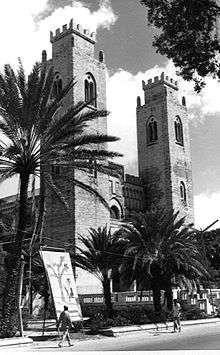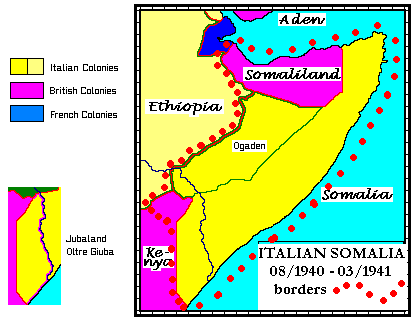Catholic Church in Somalia

The Catholic Church in Somalia is part of the worldwide Catholic Church, under the spiritual leadership of the Pope in Rome.
Overview
There are very few Catholics in Somalia, with only about one hundred practitioners as of 2004.[1]
The whole of the country forms a single diocese, the Diocese of Mogadishu. During the pre-independence period, there were, at its peak in 1950, 8,500 Catholics in the Diocese of Mogadishu (0.7% of the nation's population), almost all of whom were expatriate Italians.[1] Catholics are not allowed to proselytise, especially to Muslims.
Muslims who change their faith to Catholicism, are subject to societal and official pressure, which may lead to death penalty. However, there are cases in which a Muslim will adopt the Christian faith, secretly declaring his/her apostasy. In effect, they are practising Catholics, but legally Muslims; thus, the statistics of Somali Catholics does not include Muslim apostates to Catholic Christianity.
History
Catholicism was introduced in Italian Somaliland in the late 19th century.[2] Initially, it was only practiced by the few Italian immigrants in Mogadishu and the Shebelle River farmer areas, thanks to some missionaries of the Trinitarian Fathers[3].
After World War I, many Bantus, the descendants of former slaves, became Catholics[4]. They were principally concentrated in the Villaggio Duca degli Abruzzi and Genale plantations.[5]
In 1895, the first 45 Bantu slaves were freed by the Italian colonial authorities under the administration of the chartered Catholic company Filonardi. The former were later converted to Catholicism. Massive emancipation and conversion of slaves in Somalia[6] only began after the anti-slavery activist Father Robecchi Bricchetti informed the Italian public about the local slave trade and the indifferent attitude of the Italian colonial government toward it.[7]
After obtaining Jubaland from the British, the Italian colonial administration gave land to Italian settlers for the production of cash crops that would then be exported to Italy. Requiring labor to work these plantations, the Italian authorities attempted to recruit Bantu ex-slaves, singling out the latter community for this purpose. However, the Italians soon also had to resort to forced labor (essentially slavery) when they found that volunteers, many of whom found it more profitable to work as free yeoman, were not forthcoming.[8] This forced labor came from the Bantu populations that were settled along the Shebelle River, and not from the nomadic Somalis.[9]
Slavery in southern Somalia lasted until early into the 20th century, when it was finally abolished by the Italian authorities in accordance with the Belgium protocol and with the Diocese of Mogadishu.
In 1928, a Catholic cathedral was built in Mogadishu by order of Cesare Maria De Vecchi, a catholic governor of "Somalia italiana" who promoted the "Missionari della Consolata" christianization of Somalian people[10]. The cathedral, the biggest in Africa in the 1920s and 1930s, was later destroyed during the civil war of the 1990s.
The Bishop of Mogadishu Franco Filippini declared in 1940 that there were about 40,000 Somali Catholics due to the work of missionaries in the rural regions of Juba and Shebelle, but WWII damaged in an irreversibly way most of the catholic missions in Italian Somalia.[11] Most were somali Bantu,[12] but some thousands were illegitimate sons of Italian soldiers and somalian girls (who received Italian citizenship when baptized).
In the 1950s Indro Montanelli wrote on Il Borghese that Italian Mogadishu in 1942 after the arrival of the British was an African capital where most of inhabitants were Catholics: he indicated that of the 90,000 inhabitants more than 40,000 were Italians, while inside the 50,000 Somalis there were nearly 7,000 Catholics (including the many illegitimate sons of Italian soldiers and Somalis native girls, who were baptized in order to get Italian identification). This was meaning to him that nearly 3 out of 5 Mogadiscio inhabitants were Catholics)[13].
Since the end of the colonial period and the departure of the Italians, Catholicism has experienced a nearly complete disappearance in Somalia,[14] with the Diocese of Mogadishu estimating that there were only 100 Catholics in Somalia in 2004, down from 8,500 practitioners in 1950 during the height of the colonial period.[1]
The last Bishop of Mogadishu, Salvatore Colombo, was murdered in 1989.[15] This was followed by the murder of an Italian nun, Leonella Sgorbati, in 2006, and the desecration of Christian graves.[16]
See also
Notes
- 1 2 3 Catholic Church in Somalia
- ↑ Gresleri, G. Mogadiscio ed il Paese dei Somali: una identita negata. p. 45
- ↑ Lucia Ceci. "Il Vessillo e la Croce" (pp. 27-168)
- ↑ Photo of the Trinitarian missionaries' catholic school in Gelib
- ↑ Gresleri, G. Mogadiscio ed il Paese dei Somali: una identita negata. p.71
- ↑ Tripodi, Paolo. The Colonial Legacy in Somalia. p. 65
- ↑ History of Somali Bantu Archived 2011-11-01 at the Wayback Machine.
- ↑ Catherine Lowe Besteman, Unraveling Somalia: Race, Class, and the Legacy of Slavery, (University of Pennsylvania Press: 1999), pp. 87-88
- ↑ David D. Laitin, Politics, Language, and Thought: The Somali Experience, (University Of Chicago Press: 1977), p.64
- ↑ The catholic missionaries of "Consolata" promoted by governor De Vecchi (in Italian)
- ↑ Tripodi, Paolo. The Colonial Legacy in Somalia. p. 66
- ↑ Photo of Somali Bantu with a Missionary of the "Consolata" in 1937
- ↑ Montanelli wrote in the first Borghese editions; John Francis Lane. "Obituary: Indro Montanelli". The Guardian.
- ↑ Gresleri, G. Mogadiscio ed il Paese dei Somali: una identita negata. p.96
- ↑ The murder of Bishop Colombo
- ↑ Widspread desecration of Christian graves in Somalia
Bibliography
- Ceci, Lucia. Il Vessillo e la Croce - Colonialismo, missioni cattoliche e islam in Somalia (1903-1924)Carocci editore. Roma, 2006 ISBN 978-88-430-4050-6 ()
- Gresleri, G. Mogadiscio ed il Paese dei Somali: una identita negata. Marsilio editori. Venezia, 1993
- Tripodi, Paolo. The Colonial Legacy in Somalia. St. Martin's Press. New York, 1999.
